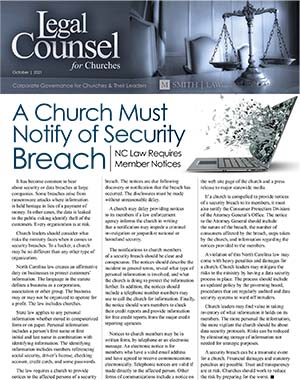Keeping effective records of all official meetings is an important job for the governing board of a church. Minutes memorialize actions for historical purposes. Minutes help inform future boards of the rationale for past policy choices. A written record can help demonstrate the board’s diligence to its fiduciary duties.
The minutes-keeping role is usually delegated to the elected Secretary. In some instances, a staff person is appointed assistant secretary to attend meetings and record the minutes. However, all directors share in the responsibility to have effective minutes. The board should review and approve the minutes.
There is no single correct way to take minutes. The content, length, and format should be the style most useful to the church. The minutes should be written clearly so all audiences will understand the dialog. Minutes can be a list of actions only or more narrative to simulate the conversations.
The board should decide beforehand who will serve as recording secretary. This person will double-check to see if a quorum is present to take official action. The agenda for the meeting should be established at the outset so the members may know the purpose of the meeting and what topics are planned for discussion.
The secretary can get a head start on the minutes by drafting an outline of the agenda in advance. This practice saves time by allowing the secretary to organize notes in the order anticipated by the agenda.
Some organizations allow directors to take extemporaneous notes of the meetings. This can help directors organize their thoughts during the meetings. Churches may ask directors to leave behind or destroy these notes. The purpose here is so the minutes remain the only official documentation of the meeting.
Some churches record meetings and later transcribe the minutes to a writing. For church boards that make audio recordings of the meetings, the audio files should be erased after the minutes are transcribed. This will help ensure only one official record remains for historical purposes.
The utility of preserving one official set of minutes can be important during litigation. If the church is sued, the other party may request copies of all records surrounding an issue. Undeleted audio recordings and handwritten notes by directors may conflict with the approved minutes. The conflict could present legal obstacles for the church.
The minutes need not be a word-for-word transcript of the conversations. There should be enough information for a reader to reconstruct what was discussed, gather the salient points and understand what decisions were made.
The secretary should be careful to keep the minutes objective. Personal comments and thoughts should not be included in the minutes. If a legal matter is discussed, avoid details that may void the attorney-client privilege.
While memories are fresh, the secretary should prepare a draft set of minutes as soon as possible after the meeting ends. The draft may be shared with a few others to help check for typographic errors or missing information. The minutes should be distributed to the directors before the next meeting with sufficient time to be read.
After the final version of the minutes are approved by the board, the minutes should be signed by the secretary and stored. The storage for minutes could be a physical document or an electronic file.
Effective minutes is an essential governance function for churches. Careful attention to the minutes will help ensure each meeting is preserved the right way. More importantly, effective minutes can lower risks the church faces.
The Following Items May Be Included In The Minutes:
- The date, location and starting time of the meeting
- The type of meeting (regularly scheduled or called meeting)
- In person, video conference or telephonic
- List of the directors, staff, and guests in attendance
- List of absent directors
- Determination of a quorum
- Name of person serving as secretary
- Approval of the previous minutes
- Outline of the matters for discussion
- Actions taken with who made motions and seconds
- Names of those who voted “no” to an action
- The final decision of the board or assembly
- Reference to supporting documents or reports presented during the meeting
- Notation whether the directors went into executive session
- A tracking of any persons that come and go from the meeting

